Abstract
Evidence is presented that near-ultraviolet (near-UV) light can alter galactoside transport in Escherichia coli in several independent ways. It can inactivate the permease system per se, it can interfere with metabolic energy production or transfer, and it can cause an increase in the generalized permeability of the membrane. Earlier publications suggested that near-UV destroys cofactors needed for electron transport and thus places a limitation on energy reserves. In agreement, we found that the active accumulation of [14C]thiomethyl-beta-D-galactopyranoside is decreased after irradiation by a larger factor than that due to action directly on the permease system. The effect on the latter was measured by the decrease in the rate of o-nitrophenyl-beta-D-galactopyranoside (ONPG) transport. As evidence that energy supplies for this "downhill" process did not become rate limiting after irradiation, we found that carbonylcyanide-m-chlorophenyl-hydrazone did not stimulate ONPG transport of irradiated cells. Cells genetically deficient in functional permease or cells treated with formaldehyde still transport ONPG passively, although at much lower rates. With the use of such cells, it was found that high fluences (doses) made the cells leaky. Further evidence that the permease system and the metabolic energy system can be inactivated independently is also presented. It is shown that a photoproduct from the irradiation of chloramphenicol inactivates the permease system much more efficiently than the energy system. In addition, it is shown that thio-beta-D-digalactopyranoside protects the permease system, but not the energy system, both against direct inactivation by near-UV and against photosensitized inactivation in the presence of chloramphenicol.
Full text
PDF
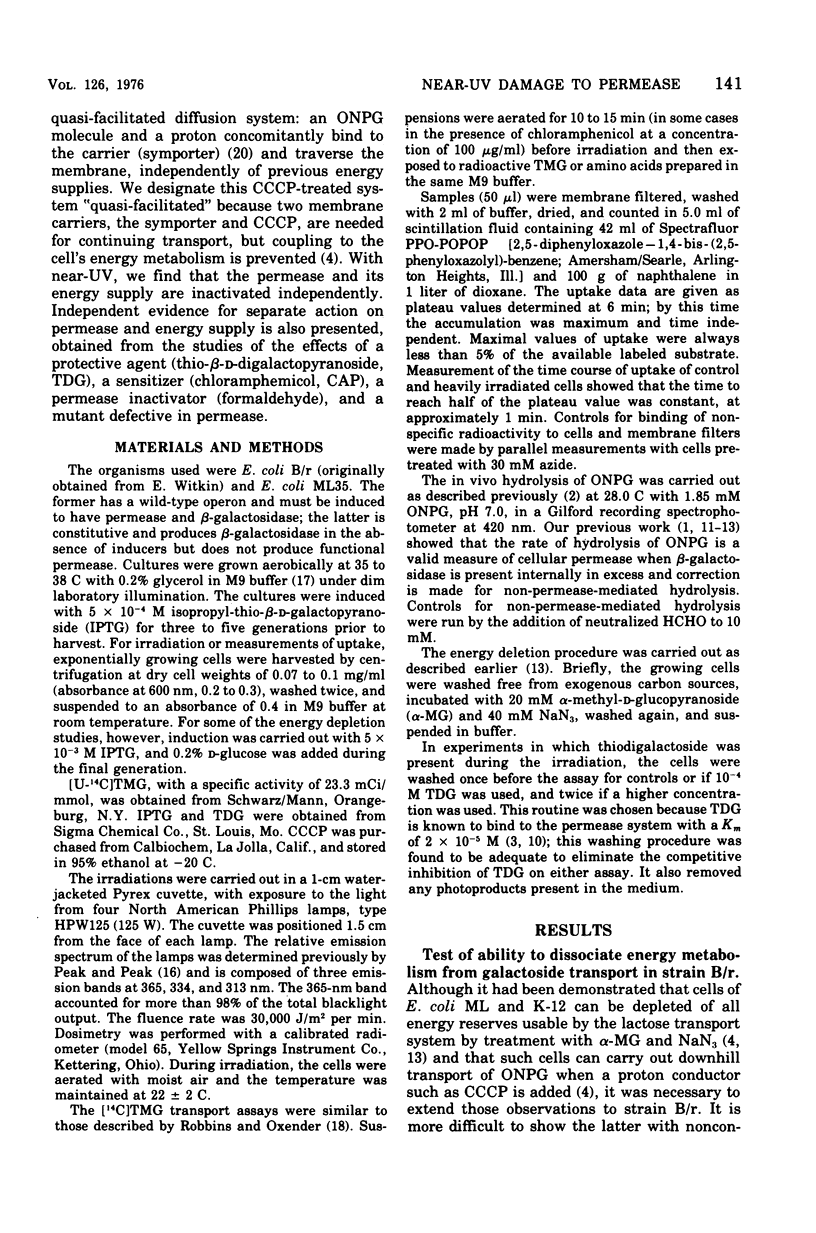
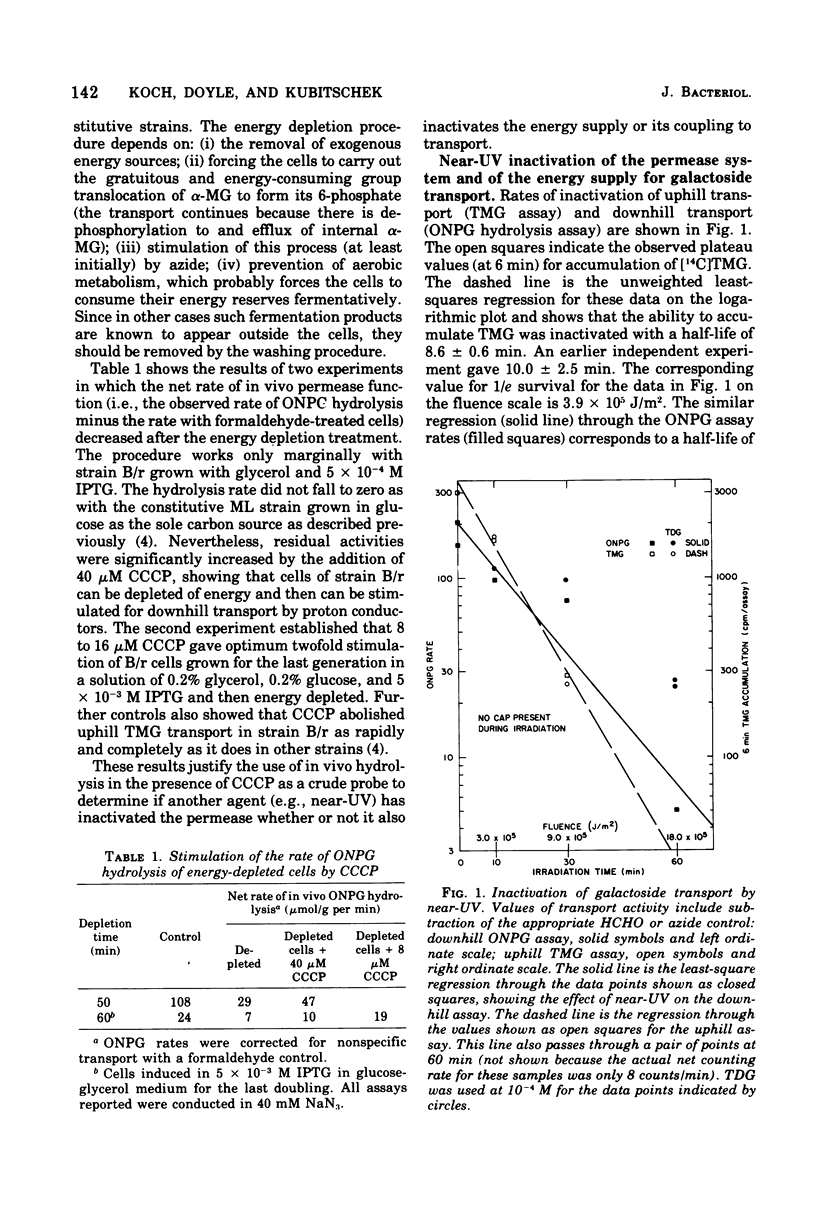
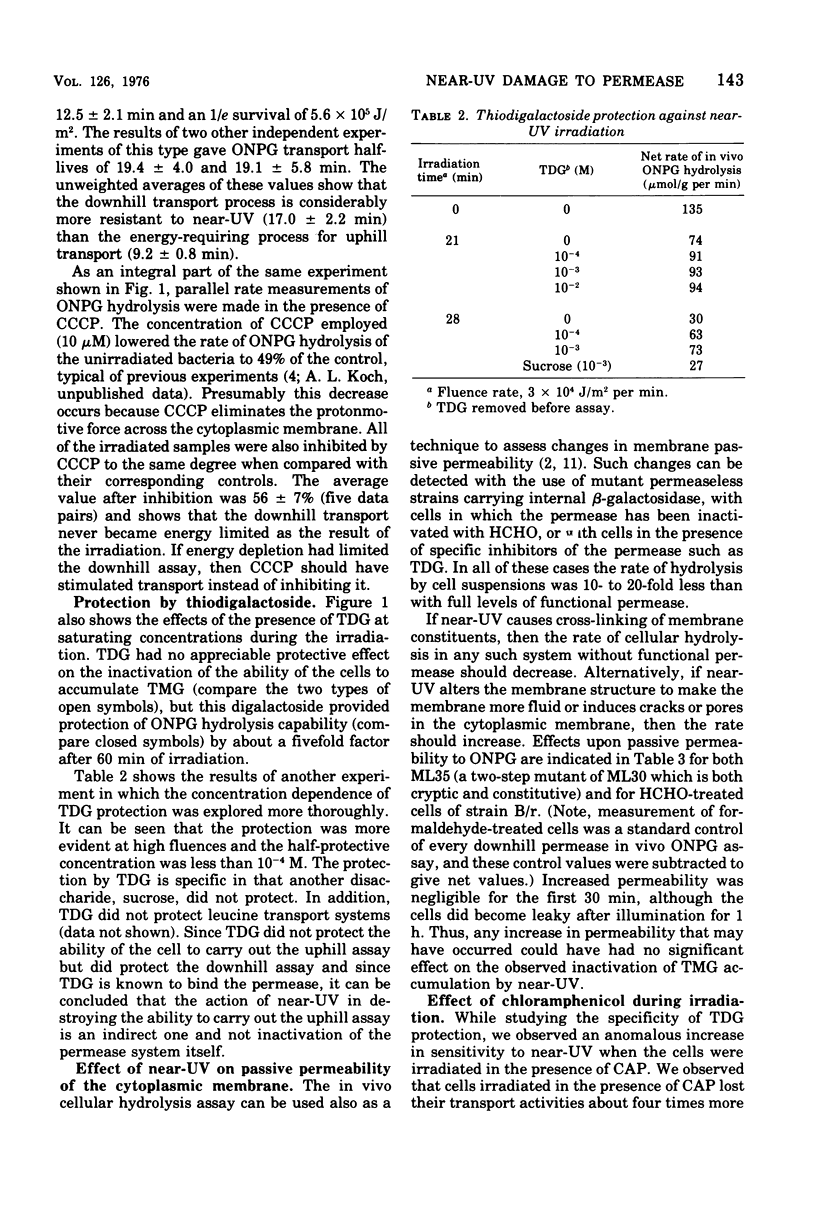
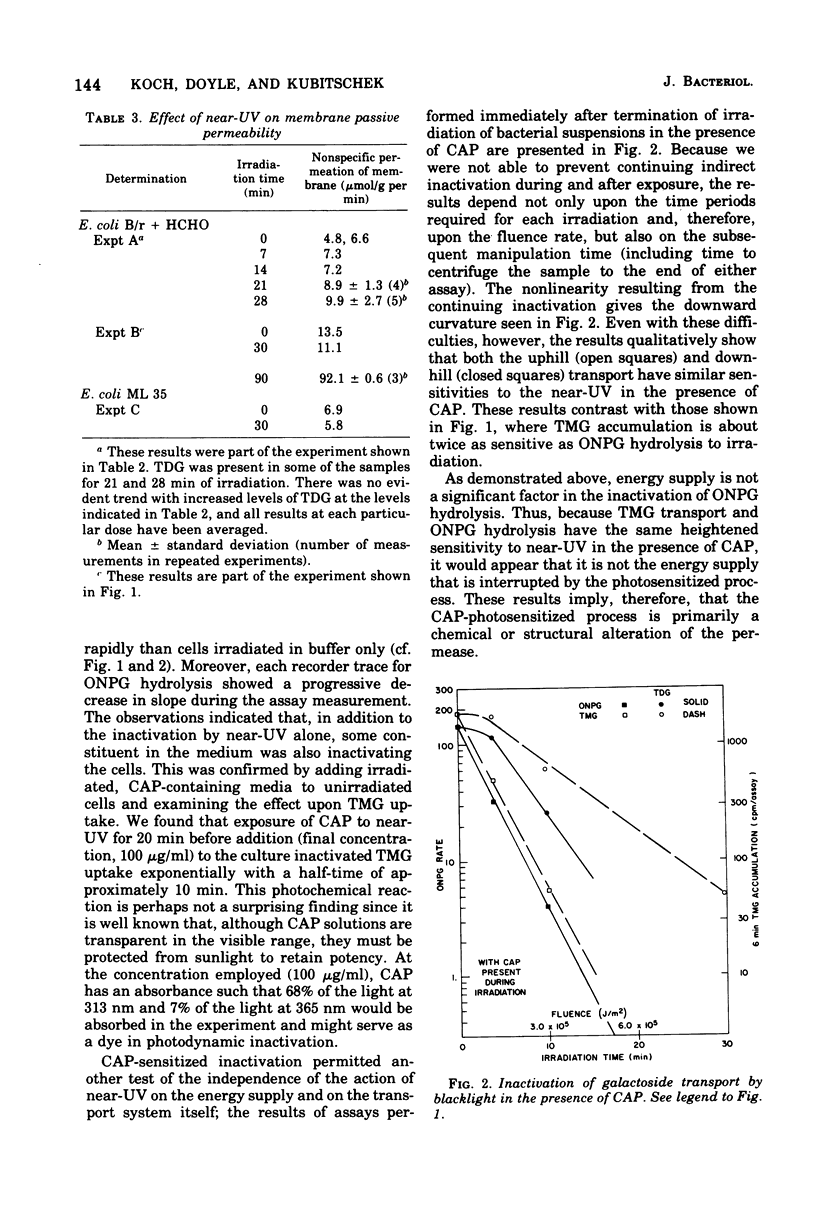
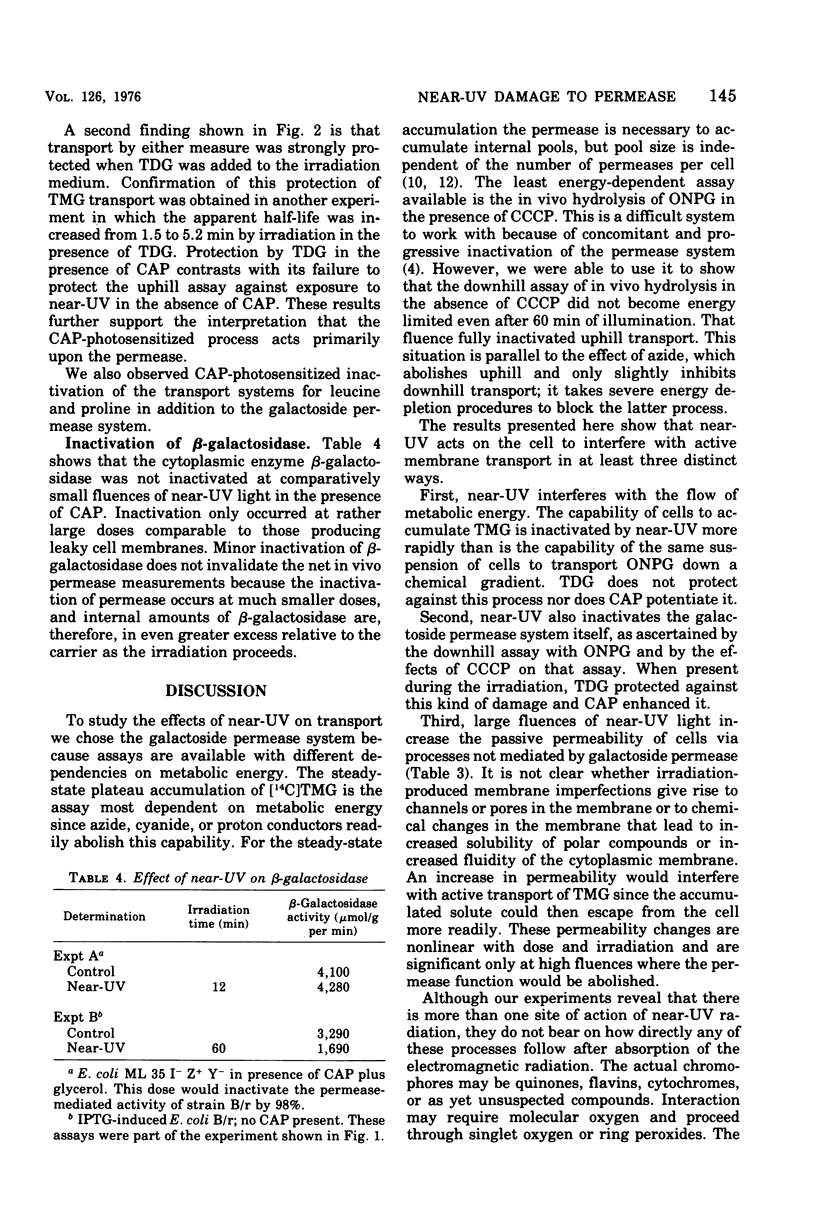
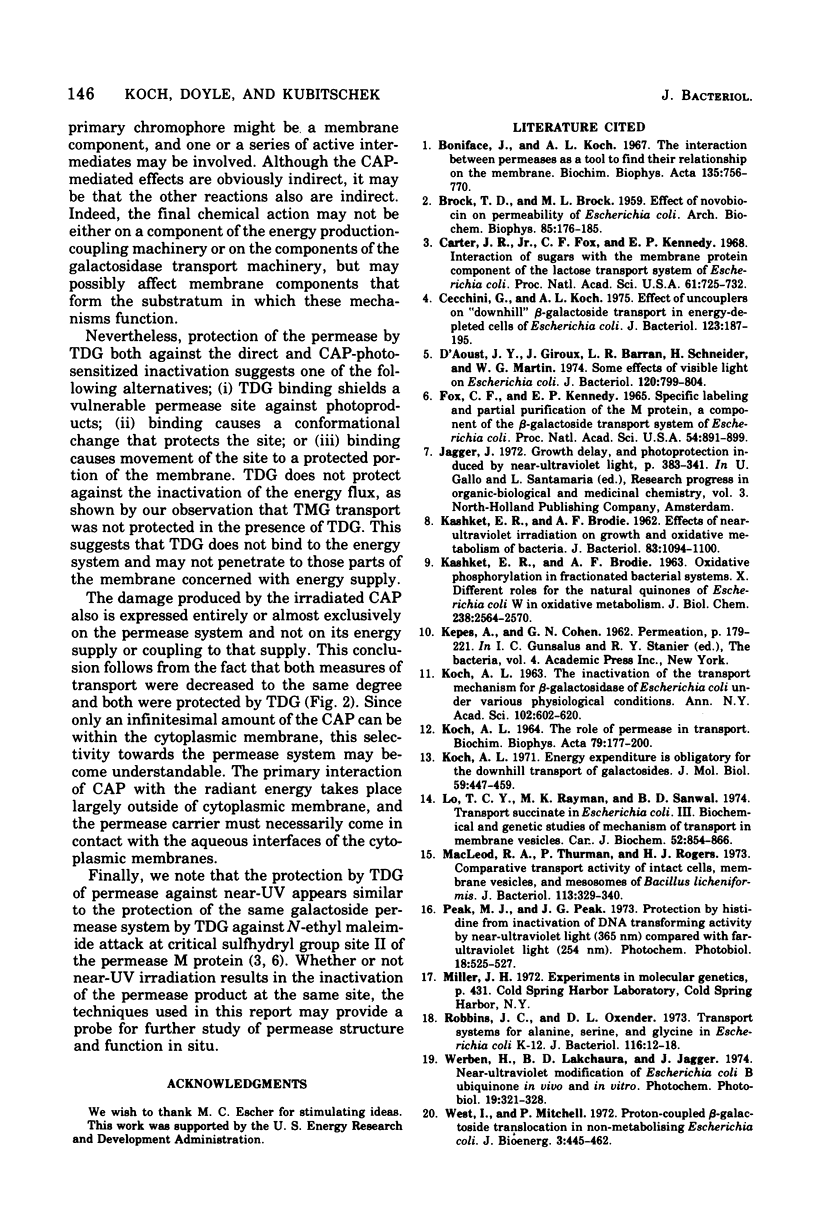
Selected References
These references are in PubMed. This may not be the complete list of references from this article.
- BROCK T. D., BROCK M. L. Effect of novobiocin on permeability of Escherichia coli. Arch Biochem Biophys. 1959 Nov;85:176–185. doi: 10.1016/0003-9861(59)90461-8. [DOI] [PubMed] [Google Scholar]
- Boniface J., Koch A. L. The interaction between permeases as a tool to find their relationship on the membrane. Biochim Biophys Acta. 1967 Sep 9;135(4):756–770. doi: 10.1016/0005-2736(67)90107-1. [DOI] [PubMed] [Google Scholar]
- Carter J. R., Fox C. F., Kennedy E. P. Interaction of sugars with the membrane protein component of the lactose transport system of Escherichia coli. Proc Natl Acad Sci U S A. 1968 Jun;60(2):725–732. doi: 10.1073/pnas.60.2.725. [DOI] [PMC free article] [PubMed] [Google Scholar]
- Cecchini G., Koch A. L. Effect of uncouplers on "downhill" beta-galactoside transport in energy-depleted cells of Escherichia coli. J Bacteriol. 1975 Jul;123(1):187–195. doi: 10.1128/jb.123.1.187-195.1975. [DOI] [PMC free article] [PubMed] [Google Scholar]
- D'Aoust J. Y., Giroux J., Baraan L. R., Schneider H., Martin W. G. Some effects of visible light on Escherichia coli. J Bacteriol. 1974 Nov;120(2):799–804. doi: 10.1128/jb.120.2.799-804.1974. [DOI] [PMC free article] [PubMed] [Google Scholar]
- Fox C. F., Kennedy E. P. Specific labeling and partial purification of the M protein, a component of the beta-galactoside transport system of Escherichia coli. Proc Natl Acad Sci U S A. 1965 Sep;54(3):891–899. doi: 10.1073/pnas.54.3.891. [DOI] [PMC free article] [PubMed] [Google Scholar]
- Jagger J. Growth delay and photoprotection induced by near-ultraviolet light. Res Prog Org Biol Med Chem. 1972;3(Pt 1):383–401. [PubMed] [Google Scholar]
- KASHKET E. R., BRODIE A. F. Effects of near-ultraviolet irradiation on growth and oxidative metabolism of bacteria. J Bacteriol. 1962 May;83:1094–1100. doi: 10.1128/jb.83.5.1094-1100.1962. [DOI] [PMC free article] [PubMed] [Google Scholar]
- KOCH A. L. THE ROLE OF PERMEASE IN TRANSPORT. Biochim Biophys Acta. 1964 Jan 27;79:177–200. doi: 10.1016/0926-6577(64)90050-6. [DOI] [PubMed] [Google Scholar]
- KOCH A. L. The inactivation of the transport mechanism for beta-galactosides of Escherichia coli under various physiological conditions. Ann N Y Acad Sci. 1963 Jan 21;102:602–620. doi: 10.1111/j.1749-6632.1963.tb13663.x. [DOI] [PubMed] [Google Scholar]
- Koch A. L. Energy expenditure is obligatory for the downhill transport of galactosides. J Mol Biol. 1971 Aug 14;59(3):447–459. doi: 10.1016/0022-2836(71)90309-3. [DOI] [PubMed] [Google Scholar]
- Lo T. C., Rayman M. K., Sanwal B. D. Transport of succinate in Escherichia coli. III. Biochemical and genetic studies of the mechanism of transport in membrane vesicles. Can J Biochem. 1974 Oct;52(10):854–866. doi: 10.1139/o74-122. [DOI] [PubMed] [Google Scholar]
- MacLeod R. A., Thurman P., Rogers H. J. Comparative transport activity of intact cells, membrane vesicles, and mesosomes of Bacillus licheniformis. J Bacteriol. 1973 Jan;113(1):329–340. doi: 10.1128/jb.113.1.329-340.1973. [DOI] [PMC free article] [PubMed] [Google Scholar]
- Peak M. J., Peak J. G. Protection by histidine from inactivation of DNA transforming activity by near-ultraviolet light (365 nm) compared with far-ultraviolet light (254 nm). Photochem Photobiol. 1973 Dec;18(6):525–527. doi: 10.1111/j.1751-1097.1973.tb06458.x. [DOI] [PubMed] [Google Scholar]
- Robbins J. C., Oxender D. L. Transport systems for alanine, serine, and glycine in Escherichia coli K-12. J Bacteriol. 1973 Oct;116(1):12–18. doi: 10.1128/jb.116.1.12-18.1973. [DOI] [PMC free article] [PubMed] [Google Scholar]
- Werbin H., Lakchaura B. D., Jagger J. Near-ultraviolet modification of Escherichia coli B ubiquinone in vivo and in vitro. Photochem Photobiol. 1974 May;19(5):321–328. doi: 10.1111/j.1751-1097.1974.tb06519.x. [DOI] [PubMed] [Google Scholar]
- West I., Mitchell P. Proton-coupled beta-galactoside translocation in non-metabolizing Escherichia coli. J Bioenerg. 1972 Aug;3(5):445–462. doi: 10.1007/BF01516082. [DOI] [PubMed] [Google Scholar]


